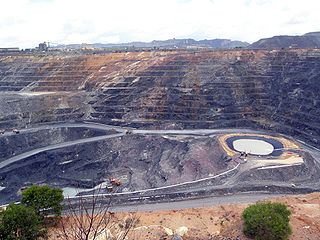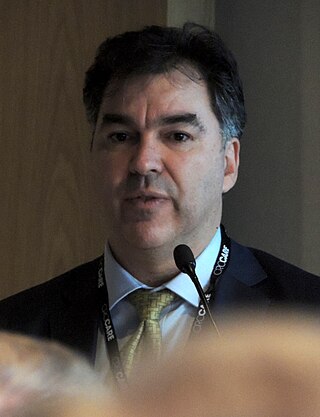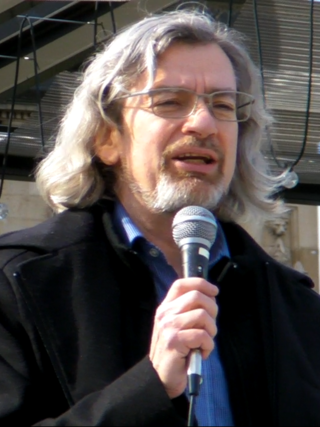Related Research Articles

Jabiluka is a pair of uranium deposits and mine development in the Northern Territory of Australia that was to have been built on land belonging to the Mirarr clan of Aboriginal people. The mine site is surrounded by, but not part of, the World Heritage–listed Kakadu National Park.
The Uranium Information Centre (UIC) was an Australian organisation primarily concerned with increasing the public understanding of uranium mining and nuclear electricity generation.

Uranium mining is the process of extraction of uranium ore from the ground. Over 50 thousand tons of uranium were produced in 2019. Kazakhstan, Canada, and Australia were the top three uranium producers, respectively, and together account for 68% of world production. Other countries producing more than 1,000 tons per year included Namibia, Niger, Russia, Uzbekistan, the United States, and China. Nearly all of the world's mined uranium is used to power nuclear power plants. Historically uranium was also used in applications such as uranium glass or ferrouranium but those applications have declined due to the radioactivity of uranium and are nowadays mostly supplied with a plentiful cheap supply of depleted uranium which is also used in uranium ammunition. In addition to being cheaper, depleted uranium is also less radioactive due to a lower content of short-lived 234
U and 235
U than natural uranium.

Mining in Australia has long been a significant primary sector industry and contributor to the Australian economy by providing export income, royalty payments and employment. Historically, mining booms have also encouraged population growth via immigration to Australia, particularly the gold rushes of the 1850s. Many different ores, gems and minerals have been mined in the past and a wide variety are still mined throughout the country.

Energy Resources of Australia Ltd is a public company based in Australia. It is a subsidiary of the Rio Tinto Group which as of 2021 owns 86.3% of the company. The remainder is publicly held and traded on the Australian Securities Exchange. The chairman is Peter McMahon and Chief Executive is Andrea Sutton.

Kakadu National Park, located in the Northern Territory of Australia, possesses within its boundaries a number of large uranium deposits. The uranium is legally owned by the Australian Government, and is sold internationally, having a large effect on the Australian economy. The mining has been controversial, due to the widespread publicity regarding the potential danger of nuclear power and uranium mining, as well as because of objections by some Indigenous groups. This controversy is significant because it involves a number of important political issues in Australia: Native Title, the environment, and Federal-State-Territory relations.
Paladin Energy Ltd is a Western Australian based uranium production company.

Nuclear weapons testing, uranium mining and export, and nuclear power have often been the subject of public debate in Australia, and the anti-nuclear movement in Australia has a long history. Its origins date back to the 1972–1973 debate over French nuclear testing in the Pacific and the 1976–1977 debate about uranium mining in Australia.

Nuclear power in Australia has been a topic of debate since the 1950s. Australia has one nuclear reactor in Lucas Heights, New South Wales, although it is only used to produce radioisotopes for nuclear medicine, and does not produce electricity. Australia hosts 33% of the world's proven uranium deposits, and is currently the world’s third largest producer of uranium after Kazakhstan and Canada.
The Minerals Council of Australia (MCA) is an industry association, notable for representing companies that generate most of Australia's mining output. The MCA was founded in 1995, succeeding the Australian Mining Industry Council which was established in 1960. It is unrelated to the former Australian Minerals Council, which was established in 1946 as an intergovernmental forum between state and federal government ministers.

The mineral mining industry is a crucial piece of the Economy of Niger. Exports of minerals consistently account for 40% of exports.

Radioactive ores were first extracted in South Australia at Radium Hill in 1906 and Mount Painter in 1911. 2,000 tons of ore were treated to recover radium for medical use. Several hundred kilograms of uranium were also produced for use in ceramic glazes.

Namibia has one of the richest uranium mineral reserves in the world. There are currently two large operating mines in the Erongo Region and various exploration projects planned to advance to production in the next few years.
The world's largest producer of uranium is Kazakhstan, which in 2019 produced 43% of the world's mining output. Canada was the next largest producer with a 13% share, followed by Australia with 12%. Uranium has been mined in every continent except Antarctica.

The Olympic Dam mine is a large poly-metallic underground mine located in South Australia, 550 km (340 mi) NNW of Adelaide. It is the fourth largest copper deposit and the largest known single deposit of uranium in the world. Copper is the largest contributor to total revenue, accounting for approximately 70% of the mine's revenue, with the remaining 25% from uranium, and around 5% from silver and gold. BHP has owned and operated the mine since 2005. The mine was previously owned by Western Mining Corporation. Since the 1970s environmentalists, traditional owners and others have campaigned against the mine, largely on the basis of its contribution to the nuclear cycle and its use of underground water.

The South Australian Chamber of Mines and Energy (SACOME) is a not-for-profit, non-government organisation founded in 1979. It represents approximately 130 companies involved in resource extraction and supporting service industries in South Australia.

Daniel Zavattiero is an Australian advocate representing the interests of the nation's uranium mining sector. He is a career mining and metals marketing professional who represents the uranium mining portfolio for the Minerals Council of Australia.

David Noonan is an Australian environmentalist and member of the anti-nuclear movement in Australia. Noonan is a former anti-nuclear campaigner for the Australian Conservation Foundation, and has been a prominent spokesperson during campaigns against the expansion of uranium mining in Australia and against the establishment of nuclear waste storage facilities. He has a science degree and a Masters in Environmental Studies.
The nuclear industry in South Australia is focused on uranium mining, milling and the export of uranium oxide concentrate for use in the production of nuclear fuel for nuclear power plants. The state is home to the world's largest known single deposit of uranium, which is worked by BHP at the Olympic Dam mine.
References
- ↑ "Australian Uranium Association". Zeus Resources. Archived from the original on 14 February 2015. Retrieved 14 February 2015.
- ↑ "Uranium Information Centre:Australian Uranium Association Ltd". Uranium Information Centre. 2007. Archived from the original on 20 December 2007. Retrieved 30 January 2008.
- ↑ "Paydirt Uranium Conference". 18 February 2011. Archived from the original on 18 February 2011. Retrieved 27 June 2015.
- ↑ "Presenters - Daniel Zavattiero". South Australian Resources & Energy Investment Conference. 2014. Archived from the original on 12 March 2015. Retrieved 11 September 2014.
- ↑ Validakis, Vicky (14 November 2013). "Australian Mining" . Retrieved 10 September 2014.
- 1 2 "Submission to the Joint Standing Committee on Treaties: Transfer of Nuclear Material to China" (PDF). Australian Uranium Association. October 2005. Archived from the original (PDF) on 5 June 2011. Retrieved 29 January 2008.
- ↑ "World Nuclear Capacity Growth Accelerated Last Year, Group Says". Bloomberg News. 17 January 2008. Retrieved 29 January 2008.
- ↑ "Australian Uranium Association forecasts 50% increase in nuke power uranium consumption". Mineweb Holdings Limited. March 2008. Retrieved 1 February 2009.